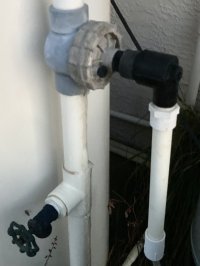I think Marine67 and Valveman experienced a failure to communicate, and the next guy to trip across this thread may be confused.
Aerator tanks have a toilet valve like mechanism to shut off the water flow through spray nozzles used to fill the holding tank. Once this valve closes, pressure in the system builds. The pump supplying water is equipped with a pressure switch and a pressure tank.
The purpose of this combination is to allow water under pressure to flow from the pressure tank without turning on the pump. If you don't have one of these, then every time you turn on the water, the pump would come on, which would greatly shorten the working life of the electric motor.
However, where I think the failure to communicate entered into things is Marine67 believes the mechanical float valve is what controls the pump. It doesn't, it just controls the build up of pressure.
So it's the actual float valve shutting off the flow of water, thus allowing pressure to build (obviously, because when the valve is open, then in effect the system has a leak). And it's the build up in pressure with the valve closed, which is what the pressure-switch equipped pump uses to turn on and off).
So it seems like cause and effect - and it is - but it's indirectly.
And it does not function in the same way as a water-level switch (a direct method of turning the pump off and on). This works because there's an electric device - a switch - mounted within the aerator tank. The direct water level switch must have a wired electrical connection between the float mechanism within the tank, and the pump. No electrical connection, then what turns the pump on and off is a mechanical valve controlling flow and thus, pressure, instead.
So one method, the toilet valve, shuts off the water as the float rises thus allowing pressure to build and the pump equipped with a pressure switch (and pressurized holding tank) turns off. Thus, when you use water, the level in the holding tank goes down, and the pump comes back on to replenish the supply.
The other method uses an electric switch to make and break an electric circuit to turn the pump on/off as water is used.

